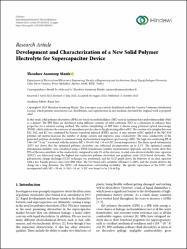| dc.contributor.author | Manfo, Theodore Azemtsop | |
| dc.date.accessioned | 2023-11-13T07:50:54Z | |
| dc.date.available | 2023-11-13T07:50:54Z | |
| dc.date.issued | 2023 | en_US |
| dc.identifier.citation | Manfo, T.A. (2023). Development and Characterization of a New Solid Polymer Electrolyte for Supercapacitor Device. International Journal of Electrochemistry, 2023, 4825624. https://doi.org/10.1155/2023/4825624 | en_US |
| dc.identifier.issn | 2090-3529 | |
| dc.identifier.issn | 2090-3537 | |
| dc.identifier.uri | https://doi.org/10.1155/2023/4825624 | |
| dc.identifier.uri | https://hdl.handle.net/11436/8662 | |
| dc.description.abstract | In this study, solid polymer electrolytes (SPEs) are based on methylcellulose (MC) used as a polymer host and sodium iodide (NaI) as a dopant. The SPE films are developed using different contents of ethyl carbonate (EC) as a plasticizer to enhance their properties via a solution casting method. The surface morphology of SPE films is shown using polarized optical microscopy (POM), which indicates the existence of amorphous patches due to the plasticizing effect of EC. The creation of a complex between MC, NaI, and EC was confirmed by Fourier transform infrared (FTIR) spectra. A tiny amount of EC applied to the MC-NaI polymer salt matrix increases the number of charge carriers and improves ionic conductivity. The ionic conductivity of the generated polymer electrolytes is examined using electrochemical impedance spectroscopy (EIS). The high-ion conducting PE of 5.06 x 10-3 S center dot cm-1 was found with the mixture MC + 50 wt% NaI + 10 wt% EC (room temperature). The linear speed voltammetry (LSV) test shows that the optimized polymer electrolyte can withstand decomposition up to 2.5 V. The optimized sample transmission numbers were calculated using a TNM (transference number measurement) approach, and the results show that 99% of the ions contribute to the conductivity, compared to only 1% of the electrons. A solid-state electrical double-layer capacitor (EDLC) was fabricated using the highest ion-conductive polymer electrolyte and graphene oxide (GO)-based electrodes. The galvanostatic charge-discharge (GCD) technique was performed, and the GCD graph shows the behavior of an ideal capacitor with a less Faradic process and a low ESR value. The GO-based cell's columbic efficiency is 100%, and the system delivers the charge for a long duration. The EDLC cell demonstrates outstanding cyclability. The specific capacitance of the EDLC cell incorporated with MC + 50 wt. % NaI + 10 wt. % EC was found to be 154.66 F/g. | en_US |
| dc.language.iso | eng | en_US |
| dc.publisher | Hindawi | en_US |
| dc.rights | info:eu-repo/semantics/openAccess | en_US |
| dc.title | Development and characterization of a new solid polymer electrolyte for supercapacitor device | en_US |
| dc.type | article | en_US |
| dc.contributor.department | RTEÜ, Mühendislik ve Mimarlık Fakültesi, Elektrik-Elektronik Mühendisliği Bölümü | en_US |
| dc.contributor.institutionauthor | Manfo, Theodore Azemtsop | |
| dc.identifier.doi | 10.1155/2023/4825624 | en_US |
| dc.identifier.volume | 2023 | en_US |
| dc.identifier.startpage | 4825624 | en_US |
| dc.relation.journal | International Journal of Electrochemistry | en_US |
| dc.relation.publicationcategory | Makale - Uluslararası Hakemli Dergi - Kurum Öğretim Elemanı | en_US |


















